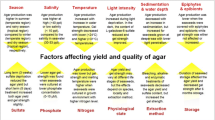Abstract
Gracilaria species have been the focus of active research that seeks to provide an alternative source of agar over that from the slower-growing Gelidium species. The quality of agar from the genus Gracilaria is highly variable. Few species tested produce agar suitable for biomedical purposes. Furthermore, the suitability is dependent upon the extraction process (Santos, 1980). If the world’s needs for quality agar are to be met in part by Gracilaria, then the species must meet initial criteria before production or mariculture experiments can be considered. The agar must be within acceptable standards and the species should have a tendency toward vegetative rather than sexual reproduction.
Access this chapter
Tax calculation will be finalised at checkout
Purchases are for personal use only
Preview
Unable to display preview. Download preview PDF.
Similar content being viewed by others
References
Beer, S. & A. Eshel, 1983. Photosynthetic carbon utilization in Ulva sp. J. Phycol. 19 (Suppl.): 5.
Bidwell, R. G. S. & J. S. Craigie, 1963. A note on the greatly reduced ability of Fucus vesiculosus to absorb or evolve CO2 when not submerged. Can. J. Bot. 41: 179–182.
Black, C. C., Jr., J. E. Burris & R. G. Everson, 1976. Influence of oxygen concentration on photosynthesis in marine plants. Aust. J. Plant Physiol. 3: 81–86.
Carritt, D. E. & J. H. Carpenter, 1966. Comparison and evaluation of currently employed modifications of the Winkler method for determining dissolved oxygen in seawater; A NASCO Report. J. mar. Res. 24: 285–318.
Cheney, D., E. Mar & J. van der Meer, 1983. Protoplast isolation in the agar-producing seaweed Gracilaria tikvahiae. Proc. 15th Miami (Florida) Winter Symp., ‘Advances in Gene Technology Molecular Genetics of Plants & Animals’, Jan. (abstract).
Doty, M. S., 1977. Seaweed resources and their culture in the South China Sea region, work plan implementation (SCS/77/WP /60). S. China Sea Fish. Dev. & Coordinating Progm, Manila, Philippines: 1–9.
Downton, W. J. S., D. G. Bishop, A. W. D. Larkum & C. B. Osmond, 1976. Oxygen inhibition of photosynthetic oxygen evolution in marine plants. Aust. J. Plant Physiol. 3: 73–79.
Edelstein, T., C. J. Bird & J. McLachlan, 1976. Studies on Gracilaria 2. Growth under greenhouse conditions. Can. J. Bot. 54: 2275–2290.
Hansen, J. E., 1980. Physiological considerations in the mariculture of red algae. In I. A. Abbott, M. S. Foster & L. F. Eklund (eds.), Pacific Seaweed Aquaculture, Calif. Sea Grant College Program, La Jolla, CA: 80–91.
Hansen, J. E., 1983. A physiological approach to mariculture of red algae. J. World Mariculture Soc. (in press).
Johnson, W. S., A. Gigon, S. L. Gulmon & H. A. Mooney, 1974. Comparative photosynthetic capacities of intertidal algae under exposed and submerged conditions. Ecology 55: 450–453.
LaPointe, B. E. & J. H. Ryther, 1978. Some aspects of the growth and yield of Gracilaria tikvahiae in culture. Aquaculture 15: 185–193.
Lloyd, N. D. H., J. L. McLachlan & R. G. S. Bidwell, 1981. A rapid infra-red carbon dioxide analysis screening technique for predicting growth and productivity of marine algae. Proc. int. Seaweed Symp. 10: 461–466.
Santos, G. A., 1980. Quality of carrageenan and agar. In I. A. Abbott, M. S. Foster & L. F. Eklund (eds.), Pacific Seaweed Aquaculture, Calif. Sea Grant College Program, La Jolla, CA: 123–129.
Shang, Y. C., 1976. Economic aspects of Gracilaria culture in Taiwan. Aquaculture 8: 1–7.
Simonetti, G., G. Giaccone & S. Pignatti, 1970. The seaweed Gracilaria confervoides, an important object for autecologic and cultivation research in the northern Adriatic Sea. Helgoländer wiss. Meeresunters. 20: 89–96.
Simpson, F. J., P. Shacklock, D. Robson & A. C. Neish, 1979. Factors affecting cultivation of Chondrus crisp us (Florideophyceae). Proc. int. Seaweed Symp. 9: 509–513.
Tseng, C. K., 1981. Marine phycoculture in China. Proc. int. Seaweed Symp. 10: 123–152.
Author information
Authors and Affiliations
Editor information
Editors and Affiliations
Rights and permissions
Copyright information
© 1984 Hydrobiologia 116/117
About this paper
Cite this paper
Hansen, J.E. (1984). Strain selection and physiology in the development of Gracilaria mariculture. In: Bird, C.J., Ragan, M.A. (eds) Eleventh International Seaweed Symposium. Developments in Hydrobiology, vol 22. Springer, Dordrecht. https://doi.org/10.1007/978-94-009-6560-7_13
Download citation
DOI: https://doi.org/10.1007/978-94-009-6560-7_13
Publisher Name: Springer, Dordrecht
Print ISBN: 978-94-009-6562-1
Online ISBN: 978-94-009-6560-7
eBook Packages: Springer Book Archive




